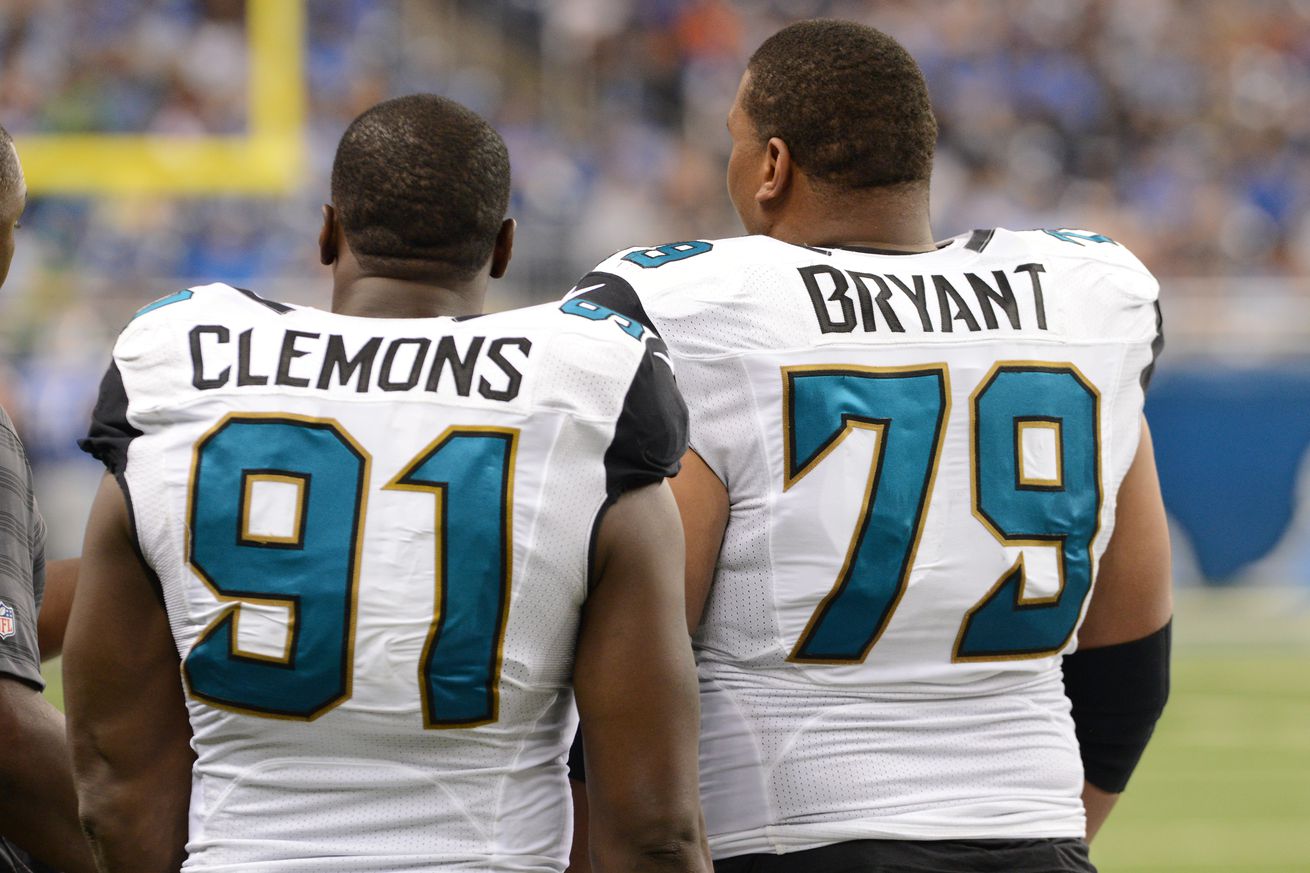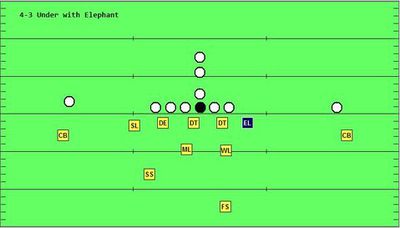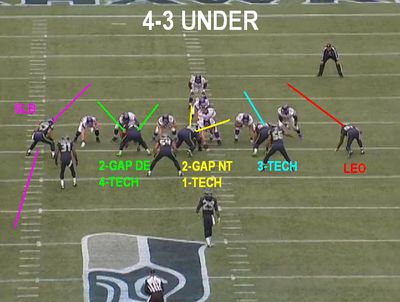
Here’s a brief reference library on the subject. Spoiler alert: While Javon Kinlaw will have a role, he is NOT the elephant end in this defense.
Javon Kinlaw has a role, but he is not an elephant end in the Dan Quinn/Seahawks defensive system
Back in March, when free agency was underway and people were trying to make sense of the Commanders’ signings, Craig Hoffman and Logan Paulsen talked about the Seahawks’ and Dan Quinn’s use of defensive end Red Bryant back in the day, and suggested that Javon Kinlaw could fill a similar role for the Commanders. Hoffman, at the time, couldn’t remember the term used by the Seahawks, but someone, somewhere, later said it was called the “elephant end”. That was almost, but not quite, right.
The term, being new to a lot of Washington fans like me, seems to have caused some confusion. I think that the use of the word ‘elephant’ called to mind the biggest land mammal, causing people to assume that the ‘elephant end’ is the biggest guy on the defensive line — a sort of displaced nose tackle. I certainly made that assumption. The fact that the podcast was talking about Red Bryant (who did not play the ‘elephant end’, but, rather, played the other defensive end position in the elephant front) probably added to the confusion.
Here’s how the position has been commonly misinterpreted by Washington media and fans based on the ‘elephant’ designation since that podcast:
The defensive tackle room depth — projected starters Daron Payne and Johnny Newton, free-agent signee/run defender Eddie Goldman and returner Sheldon Day — means Kinlaw can take snaps as the “elephant,” a lineman role Dan Quinn used with the Seattle Seahawks where a larger end focuses on run-stopping more than attacking the quarterback.
Kinlaw — like Red Bryant — is certainly big at 319 pounds, and this article correctly explains Red Bryant’s role in the Seattle (and later Jacksonville under Gus Bradley) defense, but what this article says is not actually the description of an “elephant end”.
Reading through comments here on Hogs Haven over the past day or two has made it obvious that there is growing confusion about the terminology, the position, and the relevant personnel — probably because it has been incorrectly explained by some who listened to the Take Command podcast back in March.
Today seems like a good time to throw a little light on what the elephant end means in the Pete Carroll/Dan Quinn/Gus Bradley defensive scheme.
So many animals
Of course, NFL coaches use all sorts of terminology as shorthand for specific alignments. For example:
Bear – 3 defensive linemen lined up directly across from the center and each guard with a strong safety and a linebacker lined up on the line of scrimmage on the strong side of the offensive formation. The 3 DL occupy the 3 interior OL.
Eagle – all three defensive linemen line up inside the offensive tackles. Typically, the strong outside linebacker is aligned head up on the tight end in 6-technique. The other outside linebacker can play at the line of scrimmage or off the ball. The Eagle front allows the interior three to better occupy all five offensive linemen and force double teams by alignment.
Elephant
The elephant front is simply another shorthand designation, and the ‘elephant end’ in the front isn’t a massive defensive tackle, but a linebacker or smaller defensive end, meaning that he’s definitely not the biggest guy on the defensive front.
In fact, as I read through the many articles available on the subject of the elephant front, it became clear that the term ‘elephant end’ was a bit outdated; many decade-old articles said that the term had been changed to LEO — a designation that I think is much more familiar to NFL fans.
To avoid continued confusion, it would probably be a good idea to stop talking about the “elephant end” and refer to the position as LEO.
Now, what I know about the X’s and O’s of defensive football would not cover the inside bottom surface of a thimble if spread thinly, but I know how to use Google and I know how to copy & paste. I’ve used the Wayback Machine to look at four articles written between 2010 and 2018 that explain the elephant front used in Seattle. Hopefully, these four articles taken together can comprise a mini-primer and reference library on the elephant front that can help clear up any current confusion.
Key idea – The “elephant end” and “LEO” are synonymous and refer to a smaller defensive end or an outside linebacker who is primarily a pass rusher
Field Gulls
The 4-3 Under Defense, Part I: An Introduction
2011
Seifert wanted to create mismatches against the opposing offensive line so he started using his weakside defensive end to rove around and rush the passer from a two-point stance (standing up position). This was the beginning of the “Elephant” position and one that Carroll uses today. We also see this position called the LEO, and in the Hawks’ defense can rush standing up or in a three-point stance.

[Note from Bill-in-Bangkok: in this alignment, Red Bryant would be the left DE aligned as a 5-tech between the offensive RT and TE on the strong side; the ‘elephant end’ is the player designated by the black box aligned as the right DE outside the offensive LT on the weak side]
[A]s you can see, the SAM linebacker comes up closer to the line to play hard contain and the weakside LEO is pushed out a bit, maybe a yard off of the weakside tackle. The LEO’s main job is to control the C gap while rushing the passer like a wild banshee and the SAM plays contain against the TE, runs in pass coverage with him, or rushes the passer in some situations.
The LEO can be a little bit smaller than a normal DE and Pete Carroll tends to like a more athletic and versatile body type for his Elephant position; a guy that can speed rush the QB but also react quick enough to control his gap. Must also be able to drop back into coverage occasionally in zone blitz situations.
The strongside defensive tackle can be short and squat but must be able to take on a double team consistently. The weakside defensive tackle, the 3-tech, must be your premiere interior pass rusher and have an explosive first step. His main job is to pressure the QB and stop the run in his weakside B gap. The 5-tech defensive end can be a bigger guy and must be great against the run. This is why you saw Red Bryant move out there in 2010.
[Note from Bill-in-Bangkok: Red Bryant was 6’5”, 325 pounds. This is the role that Javon Kinlaw would likely fill in the elephant front.]
Here’s the Command Center podcast from mid-March where Craig Hoffman and Logan Paulsen made the initial comparison to Red Bryant
The SAM linebacker needs to be athletic and rangy; great against the run but able to run with tight ends and running backs in pass coverage. The WILL linebacker is going to get a lot of tackles and in Pete’s system is typically a faster, smaller linebacker with range. The MIKE linebacker needs to be the field general; very instinctual and savvy. He needs to be quick enough to drop back down the middle third of the field in pass coverage in the Tampa-2 coverage. The free safety is a guy that’s going to move around a lot and be very instinctual as well. He’s going to come up to the line a lot and will get a lot of tackles. The strong safety has to be good against the run but like the free safety, will move around a lot and have to defend against the deep pass a lot. He will need to be fast and have some ball skills.
Finally, the cornerbacks need to be physical and long. They will get involved in run defense a lot so they must be good tacklers. They are protected over the top a lot of the time so typically they’re not all-world defenders but need to be pretty fast.
Seattle Times
Defense 101: Understanding how the Seahawks play
2014
Defensive line
Up front, the Seahawks try to get the best of both worlds. While Seattle uses a base 4-3, it also incorporates many elements of the 3-4. As Quinn puts it, “We happen to have lots of 3-4 looks, but we are a 4-3 team.’’
The Seahawks use a smaller defensive end who is primarily a pass rusher, a position the Seahawks call LEO.
The objective is to have three big players who can stuff the run, and faster players on the outside who can rush the passer, or at times drop back in coverage.
The front four are defined as two defensive ends (Cliff Avril, Michael Bennett are the starters) a defensive tackle (Tony McDaniel) and a nose tackle (Brandon Mebane).
Mebane lines up over the center, McDaniel between a guard and tackle on the weak side (this is also often referred to as a “three-technique tackle’’ because of the gap over which he lines up). Bennett lines up over a tackle on the strong side (or “five-technique”). [Cliff] Avril, meanwhile, is the LEO, lining up outside McDaniel on the weak side.
[Note from Bill-in-Bangkok: Cliff Avril was 6’3”, 260 pounds]
Big Cat Country
Gus Bradley’s 4-3 defense and the LEO position
2013
The Elephant front turned into it’s own position, with Carroll eventually changing the name to “Leo.” Carroll plays him in a particularly loose alignment, and he’s the one player along the front who isn’t concerned with getting one-yard upfield and anchoring in this defense. He can line up standing up or with his hand in the ground, and sole focus is to be the primary pass rusher and wreak havoc in the backfield. Ultimately, what makes Carroll’s defense unique is how the huge gap between the Leo and the next defensive lineman along the scrimmage is defended.

As you can see, the Leo (Chris Clemons for Seattle) aligns very, very wide. There’s a huge natural bubble for the offense to try and attack. It’s very inviting, but overall it’s a huge trap and plays exactly into the defensive structure. By overloading one side with massive two-gappers and bringing a safety down into the box, the linebackers are freed up with clear run-throughs and support the bubble with no hesitation. The offense can try to run into a ball of massive bodies to the strong side, or they can attack the huge weakside bubble, where they’ll be outnumbered.
[Note from Bill-in-Bangkok: Chris Clemons was 6’3”, 255 pounds]
Since the Seahawks go with so much beef up front, it’s imperative that the Leo can consistently disruptive pass rusher on the edge.
Since the Leo plays from a looser alignment and operates in space, he doesn’t need to have great size.
Bleacher Report
Seahawks defense ready to do an elephant dance
2018
The first piece of a successful 3-4 defense is a 360 pound, zero technique, nose tackle, which the Seahawks just don’t currently have on the roster. This type of defender is expected to cover two gaps and more than one offensive lineman.
The defensive ends in the 3-4 are expected to hold their blocks so that the lineman don’t get out to the linebackers. They are not expected to put much pressure on the quarterback. They are also often expected to cover more than one gap, where in the 4-3, a lineman is responsible only for a single gap.
The Seahawks’ defensive linemen don’t seem to have the size or technique for the 3-4, they all seem more suited to the 4-3, one gap system where they are responsible for shooting one gap and don’t do any stunting or holding of blocks.
With Patrick Kerney’s retirement, the Seahawks have lost their main pass rushing threat from the defensive line.
Never fear, Pete Carroll is here and with him comes the Elephant defense.
What exactly is the Elephant defense? Basically, the Elephant position is a stand up defensive end who lines up on the outside shoulder of the offensive tackle. For all [intents and] purposes it gives the impression of a 3-4 defense.
All of the gap assignments of the 4-3 lineman remain the same. The benefits are added speed up front and better pressure off the edge.
Chris Clemons, who Seattle received back as part of the Darryl Tapp trade to Philadelphia, is penciled in as the current starter at the Elephant position.
Expect the bulk of the pass pressure to come from linebackers Curry and Foley during nickel situations, and [Clemons] in the role of the Elephant.
Number one draft pick, free safety Earl Thomas, is blazing fast and was the best ballhawk in the draft, and Jordan Babineaux is a solid strong safety, who completes a solid defensive backfield that should give the pass rushers longer to get to the opposing passer this year.
So, who is likely to be the elephant end/LEO for the Commanders?
The answer here is definitely not Javon Kinlaw. He’ll play 5-technique on the strong side of the formation.
Two players who filled this role in the articles above —Chris Clemons and Cliff Avril — were each around 6’3”, 260 pounds.
In Atlanta, the players Dan Quinn used were Tak McKinley (6’2” 248) and Vic Beasley (6’3” 246). In Dallas it was Micah Parsons (6’3” 246).
If we look at the Commanders roster for defensive ends or outside linebackers who are around 6’3” and 245-260 pounds, who will we find?
